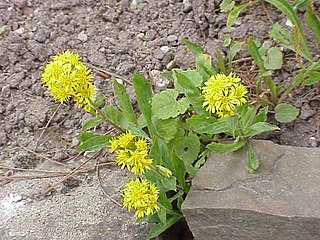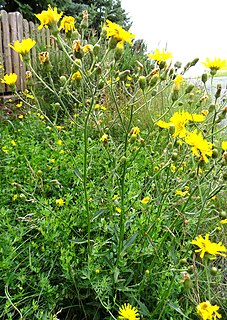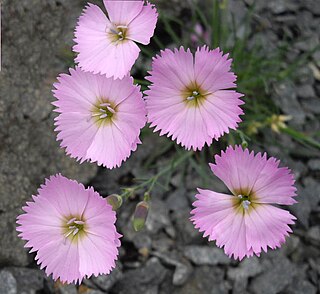
Cota tinctoria, the golden marguerite, yellow chamomile, or oxeye chamomile, is a species of perennial flowering plant in the sunflower family. Other common names include dyer's chamomile, Boston daisy, and Paris daisy. In horticulture this plant is still widely referred to by its synonym Anthemis tinctoria.

Solidago virgaurea, the European goldenrod or woundwort, is an herbaceous perennial plant of the family Asteraceae. It is widespread across most of Europe as well as North Africa and northern, central, and southwestern Asia. It is grown as a garden flower with many different cultivars. It flowers profusely in late summer.
Werner Rodolfo Greuter, in Genoa, Italy, as a Swiss national, is a botanist. He is the chair of the Editorial Committee for the International Code of Botanical Nomenclature (ICBN) - the Tokyo Code (1994) and the St Louis Code (2000). His proposed policy as regards registration of botanical names proved unpopular and in 1999 he stepped back, not being elected anew: he completed his term as chair to be succeeded at Vienna in 2005. He has returned as a member of the editorial committee, contributing to the renamed International Code of Nomenclature for algae, fungi, and plants, the "Melbourne Code" (2012).

Hieracium umbellatum, the Canadian hawkweed, Canada hawkweed, narrowleaf hawkweed, or northern hawkweed, is a flowering plant in the family Asteraceae.

Filago is a genus of plants in the sunflower family, native to Europe, Asia, and North Africa. They are sometimes called cottonroses or cudweeds.

Hieracium laevigatum, or smooth hawkweed, is a Eurasian plant species in the tribe Cichorieae within the family Asteraceae. It is widespread across much of Europe and western Asia. It is very similar to Hieracium sabaudum and can be found on dry, more or less nutrient rich soil in light woods, grassy embankments and fields, or on walls.

Artemisia campestris is a common and widespread species of plants in the sunflower family, Asteraceae. It is native to a wide region of Eurasia and North America. Common names include field wormwood, beach wormwood, northern wormwood, Breckland wormwood, boreal wormwood, Canadian wormwood, field sagewort and field mugwort.

Dittrichia viscosa, also known as false yellowhead, woody fleabane, sticky fleabane and yellow fleabane, is a flowering plant in the daisy family.

Coincya monensis is a plant species in the family Brassicaceae. Coincya monensis is native to western Europe and Morocco, but has been introduced in North America.

Cota is a genus belonging to the chamomile tribe within the sunflower family. It is native to Europe, North Africa, and southwestern Asia, with a few species naturalized elsewhere. It is an herbaceous plant with flower heads including white or yellow ray florets and yellow disc florets.

Conospermum caeruleum, commonly known as blue brother, is a shrub in the family Proteaceae and is endemic to the south west of Western Australia. It is a prostrate shrub with small, dense heads of blue, rarely pink flowers and usually grows in heavy soils subject to flooding.

Echinops spinosissimus is a European species of plants in the thistle tribe within the sunflower family. It is native to southeastern Europe, northern Africa, and southwest Asia as far east as Iran.

Dianthus sylvestris, the wood pink, is a species of Dianthus found in Europe, particularly in the Alps, and also said to be disjunctly found in the mountains of Greece. A perennial, it prefers to grow in drier, stony places, so it is occasionally planted in rock gardens.

Genista sagittalis, called the arrow-jointed broom and winged broom, is a species of flowering plant in the genus Genista, native to central and southern Europe, Ukraine, and Anatolia. Its subspecies Genista sagittalis subsp. delphinensis, called rock broom, has gained the Royal Horticultural Society's Award of Garden Merit.

Hieracium hypochoeroides, the cat's-ear hawkweed, is a species of flowering plant in the family Asteraceae, native to Europe. Hieracium hypochoeroides is a recently arisen species aggregate.

Anthemis cretica, the Cretian mat daisy or white mat chamomile, is a species of flowering plant in the family Asteraceae. It or its many subspecies can be found around the Mediterranean region, the Black Sea area, Poland, the Caucasus, and the Middle East as far as Iran. It is highly morphologically variable, and the namesake of a species complex.

Nigella arvensis, the field nigella or wild fennel flower, is a species of flowering plant in the family Ranunculaceae. It is native to North Africa, central, southern and eastern Europe, the Caucasus region, and the Middle East as far as Iran, and has gone extinct in Switzerland and Crete. It is a minor crop, used locally as a substitute for Nigella sativa, black caraway.

Ophrys holosericea, the late spider orchid, is a species of flowering plant in the family Orchidaceae, native to western and central Europe and the Mediterranean region. There has been considerable confusion about the identity of this species and the correct spelling of its name.
















